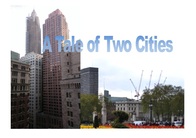 New York (left), London (right)
New York (left), London (right) London, similar to Manhattan, has had its issues with restrictions on buildings as well. Development often appears to be impeded by the process required to obtain permission to change or build an addition on listed buildings. Consent requirements have been updated recently to streamline the process of receiving permission for altering or constructing additions on locally listed as well as nationally Grade I listed buildings. (Grade I buildings are considered of exceptional interest and the highest rating of nationally listed buildings.) Christine Murray, an Architect’s Journal writer, believes this is a “kick-start development by eliminating some of the hassle of dealing with listed heritage.” While this may seem like the best of times, it is still anyone’s guess as to whether this truly resolves the struggle between progressive development and preservation. The dirty word, “demolition,” still remains untouched in the loosening of restrictive regulations.
And this is just what is at the heart of Manhattan’s issue. Progressive developers want to have full reign on being able to move forward to “bigger and better” which sometimes requires demolishing the old, while preservationists want to pull out all the stops in an effort to prevent any building over 50 years old from disappearing. In 2006 despite this being outside the purview of his position, Simon Thurley, chief executive of English Heritage, expressed his concern over the demolition of unlisted buildings outside of conservation areas on the local level in the UK. This is similar to what New York City preservationists are concerned about today; buildings not on a designated protection list, outside historic districts are threatened by potential demolition. These are the worst of times. Or are they? Could it be that gathering both preservationists and developers together to discuss the issue might provide a means to a resolution?
On May 20th, Crain’s New York Business will be hosting a forum and posing questions to five leaders in the industry from New York Landmarks Conservancy, New York YIMBY, Columbia University, the Real Estate Board of New York and the Municipal Art Society. The question in Manhattan is whether we can progress as well as preserve at the same time. Providing solutions which will satisfy both preservationists and developers may be the answer, but just what are the details satisfying to both?
Charu Ghandi, head of design at Morpheus of London put it eloquently and succinctly in an interview with Corner Magazine. Commenting on sympathy toward historic context and development she said, “You have to strike a balance between being sympathetic but also creating a new history. We don’t constantly build history by being stagnant – there’s a fine line between preservation and going backwards. You have to work hard to preserve buildings that need preserving whilst contributing to what will hopefully become part of a legacy.”
Have preservationists considered that the new buildings are the historic buildings of tomorrow? Do progressive developers plan as if they are constructing a legacy of the future? The best of times, the worst of times. If a resolution can be found at the forum on the 20th perhaps London will follow...in the best of times.
 RSS Feed
RSS Feed